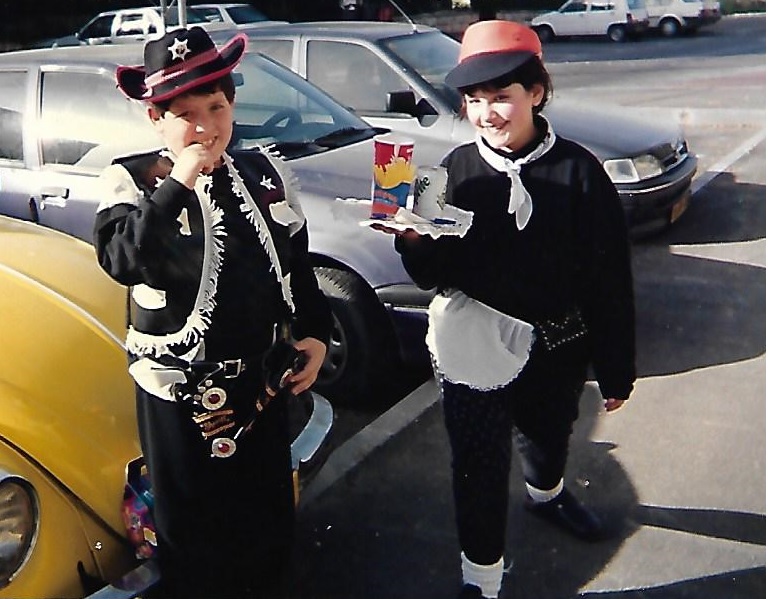Cinderella meets Jack Bower meets Halloween, wrapped in female empowerment.
Welcome to the wildest Jewish holiday of all.
- What is Purim?
- What does Purim mean?
- What are the origins of Purim?
- How do you celebrate Purim? What are the rituals and traditions of Purim?
- When is Purim?
What is Purim?
Purim (also called the Festival of Lots) is a Jewish holiday which celebrates the salvation of the Jewish people from genocide.
Haman, a high ranking official in the First Persian Empire, was planning to kill all of the Jews – and the holiday celebrates the fact that he failed to do so.
The holiday is celebrated on the 14th day of Adar, which is the twelfth month of Hebrew calendar. In Jerusalem and all other ancient walled cities, it is celebrated on the 15th day of Adar (and is called Shushan Purim). It means that it usually occurs during February or March.
What does Purim mean?
Purim means “lots” in Hebrew (and the “Pu” in “Purim” is pronounced like the “pu” in “put”).
But why is this holiday called lots?
If you want the full experience of the story (theisrael.blog style), check out the full Megillah in our next post.
And for your pleasure, here is the short version of the story. First, let’s meet the characters and set the stage:
The story takes place in Shushan, the vibrant and colorful capital of the vast First Persian Empire.
After banishing his first wife for being disobedient, king Ahasuerus, who rules the First Persian Empire, needs a new queen. The new queen is to be selected in a reality show kind of way. You are right, the female empowerment part is not yet here…
Our king selects a young, beautiful woman named Esther. She is the heroine of our story.
Esther is an orphan, raised by a relative named Mordecai. And they are both Jewish (of course). Esther keeps her Jewishness a secret, as instructed by Mordecai.
Our hero Mordecai overhears a plot to assassinate king Ahasuerus, and informs Esther. This act, which goes unrewarded (for now), saves the king’s life.
Mordecai is a hero indeed.

Ahasuerus has a very close and powerful right hand, named Haman. He is our villain.
Haman wants everybody to bow down to him as he walks by. Apparently, he really lacks self confidence.
However, Mordecai refuses to do so (since it would be considered idol worship, which is one of the three cardinal sins in Judaism), and Haman learns that it is due to Mordecai being Jewish.
Furious Haman calmly and reasonably decides to kill all of the Jews of the Empire in response. But how should he decide on the date on which all the Jews shall be killed? Easy – cast pur, that is, the lot, to decide on a date – and the 13th day of the Hebrew month Adar is the chosen date.
Ahasuerus gets on board alarmingly quickly, issuing a decree to kill all the Jews on that date.
Now it is up to Esther to foil Haman’s plans and have the decree cancelled. She asks king Ahasuerus to throw a feast honoring Haman. And a day later – she asks him to throw another feast honoring Haman.
Luckily for us, between these feasts, king Ahasuerus has trouble sleeping. As a bedtime story, the book of records of the chronicles of the kingdom is read to him. And in these chronicles, he learns of Mordecai’s acts, the very ones that saved his life, and that they went unrewarded.
The following day Ahasuerus pays the utmost respect to Mordecai, having Mordecai dressed up in royal apparel and led around riding a horse by Haman. And as if this isn’t enough, Haman has to call through the streets: “Thus shall it be done to the man whom the king wishes to honor”.
At the second feast that took place in the evening, Esther pleads Ahasuerus to save her and her people. It is only then that Ahasuerus learns that she is Jewish, and that Mordecai is about to be killed as well.
Terrorized, Haman falls onto Esther’s bed, begging for his life – as he realizes he is no longer the king’s favorite. That is unfortunate for him, as Ahasuerus thinks that Haman is imposing himself on Esther – and orders that Haman shall be hanged.

After that, Ahasuerus gives Esther ownership of Haman’s house, and gives Mordecai a promotion to the king’s hand.
Last but not least, Ahasuerus permits Esther and Mordecai to issue a new decree. And in the new decree, all of the Jews in all of the kingdom are allowed to kill those who sought to kill them, on the 13th day of the Hebrew month Adar.
Basically, it’s the Uno reverse card of decrees.
When the 13th day of the Hebrew month Adar arrives, the Jews avenge. Ahasuerus is so impressed with the number of people killed by the Jews living inside the walled city of Shushan, that he gives them an extra day to continue! So the Jews outside Shushan got to rest on the 14th, whereas the Jews in walled Shushan got to rest only on the 15th day of Adar.
And that is why Purim is celebrated on the 14th day of Adar in cities without walls, and on the 15th day in cities that had walls during that period (mainly Jerusalem).
What are the origins of Purim?
The origins of Purim is the Scroll of Esther (also known as the Book of Esther), which describes the whole story.
In Hebrew the Scroll of Esther is called Megillat Esther (which literally translates to Scroll of Esther), or the Megillah – which translates to the Scroll.
An interesting fact – the book of Esther is one of the only two books in the Hebrew Bible that do not mention God (the other is a book called Song of Songs).
Another fun fact – the book of Esther is dated to the 5th century BC. That’s a very old story indeed!
How do you celebrate Purim? What are the rituals and traditions of Purim?
Purim is a fun holiday, and so are its customs!
The most religious part of the customs is listening to a public reading of the Book of Esther twice – once in the evening and once again in the following morning. This usually happens in synagogue.
When reading Book of Esther, everyone makes noise to blot out Haman’s name – he is the villain, after all. So every time his name is read out loud, all of the listeners make loud noises, using noisy ratchets. And this happens 54 times during one reading!
Before all the feasts and celebrations, a fast takes place on the 13th of Adar. However, when that date falls on Sabbath, the fast is pushed forward to the preceding Thursday, since Friday is needed to prepare for Sabbath and the following Purim festival.
And now – let the celebrations begin!
The Book of Esther prescribes “the sending of portions from one man to another, and gifts to the poor”. So can you guess our next two customs?
That’s right!
The first custom is “sending of portions” (or “mishloach manot” in Hebrew). Each adult must give at least two different foods to one person. Usually, people buy a bunch of snacks – greasy, salty, crunchy and sweet snacks, wrap them up and give one another.
At a lot of schools and workplaces, a Jewish version of Secret Santa takes place, called “Dwarf and Giant”. Each person gets a random person from their class / workplace, and they have to bring that person portions for several days. On the other hand, they also receive portions for several days from someone else. On the last day, the identities of the givers are revealed. The person which does the giving is the dwarf, and the person receiving is the giant (and each person is both…), hence the name of the game.
The second custom is giving charity to two poor people – either food or money equivalent to the amount of food that is eaten at a regular meal.
Continuing with the food theme. On Purim day, a festive meal called the Se`udat Purim (“a feast for Purim”) is held, which involves drinking a lot of wine. In fact, the custom is that one should drink on the Festival of Lots until they can “no longer distinguish between the cursed Haman and the blessed Mordecai.” This is based on the fact that the salvation of the Jews occurred through wine, during the feasts and banquets Esther threw.
Another fun custom is costumes.
On the holiday, everyone wears costumes and / or masks, and participates in parties and carnivals. In these carnivals thousands of people take to the streets, showing off their costumes that they made (or bought) especially for the holiday. Usually party music and Purim songs are played, turning parks and streets to huge, crowded (and mostly free) parties.
A traditional food with a very weird name is Haman’s ears (or “oznei Haman” in Hebrew). These are triangular pastries filled with poppy seed, prunes, dates, apricots, apples or chocolate.
Another fried pastry, called fazuelos, is also eaten – basically thin fried dough.
And there you have it – drinking, parties, costumes and snacks.
It’s a 10/10, would definitely recommend it to a friend.
When is Purim?
2021 – begins in the evening of Thursday, 25 February and ends in the evening of Friday, 26 February
2022 – begins in the evening of Wednesday, 16 March and ends in the evening of Thursday, 17 March
2023 – begins in the evening of Monday, 6 March and ends in the evening of Tuesday, 7 March
2024 – begins in the evening of Saturday, 23 March and ends in the evening of Sunday, 24 March
2025 – begins in the evening of Thursday, 13 March and ends in the evening of Friday, 14 March

